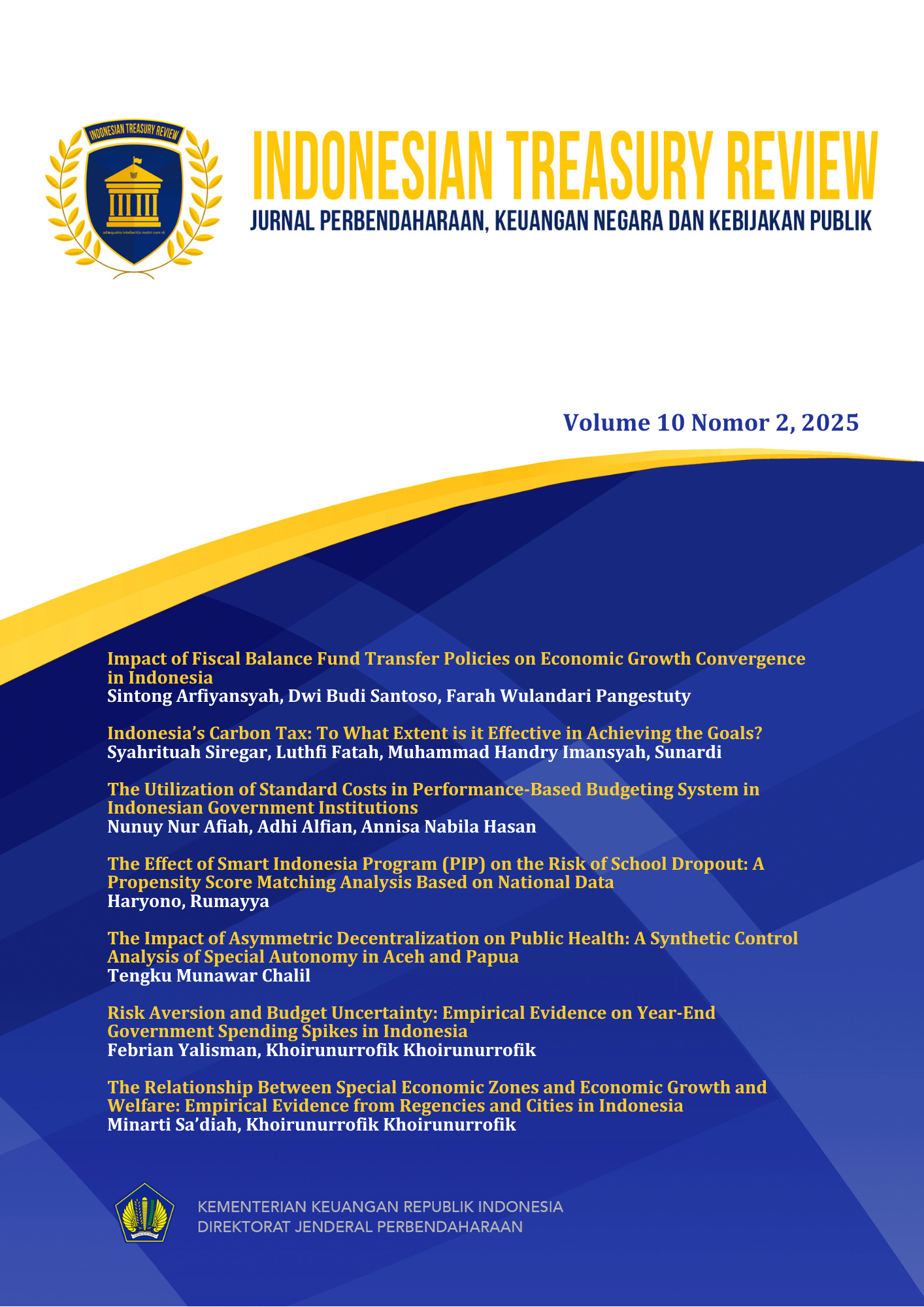Impact of Fiscal Balance Fund Transfer Policies on Economic Growth Convergence in Indonesia
Abstract
Research Originality — This research aims to analyze how fiscal balance transfers impact the acceleration of economic growth convergence in the country. Convergence means that more regions can enjoy economic growth.
Research Objectives — The research used secondary data from 2015 to 2022 and focused on 34 provinces in Indonesia.
Research Methods — This study employs a quantitative research design, with a convergence analysis framework based on panel data regression. The empirical model uses both absolute and conditional convergence methodologies to investigate the relationship between regional income levels and fiscal transfer policies. The analysis is based on secondary data from 34 Indonesian provinces between 2015 and 2022. The main explanatory variables are the per capita realizations of General Allocation Funds (DAU), Special Allocation Funds (DAK), and Revenue Sharing Funds (DBH). The fixed effects estimator is used to correct for unobserved heterogeneity, and the Hausman test is performed to assess the validity of the model definition
Implications — The central government needs to exercise vigilance in respect of the allocation of balance funds because DAK has not been able to contribute to the economic growth in Indonesia. Regional governments also need to exercise vigilance and have strong controls in using balance funds. Better planning of balance funds, which are purpose grants, needs to be facilitated through efficient spending planning and synchronized with national priorities, ensuring that balance funds can be properly absorbed by regional governments and have an impact on economic development in each region.
Full text article
References
Abramovitz, M. (1986). Catching up, forging ahead, and falling behind. The Journal of Economic History, 46(2), 385–406. https://doi.org/10.1017/S0022050700046209
Aulia, M. G., & Santoso, D. B. (2019). Analisis konvergensi pertumbuhan ekonomi Provinsi Jawa Barat tahun 2007-2016. Jurnal Ilmiah FEB Universitas Brawijaya, 7(2), 1–19.
Badan Kebijakan Fiskal. (2021). Desentralisasi Fiskal: Dua Dekade Implementasi.
Bahl, R., & Linn, J. (1994). Fiscal decentralization and intergovernmental transfers in less developed countries. Publius, 24(1), 1–19. http://www.jstor.org/stable/3330701
Barro, R. J., & Sala-I-Martin, X. (1992). Convergence. Journal of Political Economy, 100(2), 223–251. https://doi.org/10.1086/261816
Hankla, C. R. (2009). When is fiscal decentralization good for governance? Publish: The Journal of Federalism, 39(4), 632–650. https://doi.org/10.1093/publius/pjn034
Hausman, J. A. (1978). Specification Tests in Econometrics. Econometrica, 46(6), 1251–1271.
Hyman, D. N. (2010). Public Finance. Austria: Cengage Learning.
Ichimura, S., & Bahl, R. (2008). Decentralization policies in Asian Development. World Scientific Publishing Company.
Khusaini, M. (2018). Keuangan daerah. Malang: Universitas Brawijaya Press.
Kuncoro, M. (2000). Otonomi dan Pembangunan Daerah. Jakarta: Airlangga.
Michael, H. M. (2008). The tiebout hypothesis 50 years later: lessons and lingering challenges for metropolitan governance in the 21st century. Public Administration Review, 68(1), 97–109. Retrieved from http://dx.doi.org/ 10.1111/j.1540-6210.2007.00840.x
Negara, B. P., & Khoirunurrofik, K. (2021). Dampak desentralisasi fiskal terhadap konvergensi pendapatan per kapita antar kabupaten/kota di Indonesia. Indonesian Treasury Review: Jurnal Perbendaharaan, Keuangan Negara dan Kebijakan Publik, 6(1), 1–18. https://doi.org/10.33105/itrev.v6i1.185
Olsson, O. (2012). Essentials of advanced macroeconomic theory (1st ed.). Routledge. https://doi.org/10.4324/9780203139936
Reschovsky, A. (2004). The impact of state government fiscal crises on local governments and schools. State and Local Government Review, 36(2), 86-102. https://doi.org/10.1177/0160323X0403600201
Resosudarmo, B. P., & Vidyattama, Y. (2006). Regional income disparity in Indonesia: A panel data analysis. Asean Economic Bulletin, 23(1), 31–44. https://doi.org/10.1355/ae23-1c
Santoso, D. B. (2013). Budget decentralization and economic development inequality among regions in East Java. Journal of Global Bussiness and Economics, 7, 85.
Sembiring, T. A. (2020). Pengaruh pendapatan asli daerah (PAD), dana alokasi umum (DAU), dan dana alokasi khusus (DAK) fisik terhadap pembangunan manusia di Provinsi Sumatera Utara (Periode 2016 – 2018). Indonesian Treasury Review Jurnal Perbendaharaan Keuangan Negara dan Kebijakan Publik, 5(1), 77–91. https://doi.org/10.33105/itrev.v5i1.167
Solow, R. (1956). Contribution to the theory of economic growth. Quartely Journal of Economics, 70, 65-94.
Sugiyono (2019). Metode penelitian kuantitatif, kualitatif, dan R&D. Bandung: Alphabet
Sun’an, M. (2015). Ekonomi pembangunan. Mitra Wacana Media.
Szczepaniak, M., Geise, A., & Bariyah, N. (2022). Impact of institutional determinants on income inequalities in Indonesia during the Era Reformasi. Journal of Asian Economics, 82(June), 0–1. https://doi.org/10.1016/j.asieco.2022.101526
Todaro, M. P., & Smith, S. (2012). Economic development 11th Ed. USA: Pearson Higher Ed.
Oates, W.E. (1972). Studies in fiscal federalism. An Elgar. USA: The University of California.
Undang-Undang Republik Indonesia Nomor 23 Tahun 2014 tentang Pemerintahan Daerah. Lembaran Negara RI Nomor 5587.
Undang-Undang Republik Indonesia Nomor 1 Tahun 2022 tentang Hubungan Keuangan Antara Pemerintah Pusat Dan Pemerintahan Daerah. Lembaran Negara RI Nomor 6757.
Yaqin, U. A., & Herwanti, T. (2019). Analisis permasalahan pengelolaan dana alokasi umum dan dana alokasi khusus pada pemerintah daerah. Akurasi: Jurnal Studi Akuntansi dan Keuangan, 1(2), 123–136. https://doi.org/10.29303/akurasi.v1i2.9
Wibisono, Y. (2003). Konvergensi di Indonesia: Beberapa temuan awal dan implikasinya. Economic and Finance in Indonesia, 51(1), 53–82.
Williamson, J. G. (1965). Regional inequality and the process of national development: A description of the patterns. Economic Development and Cultural Change, 13(4), 1–84.
Zainuri, Z, Lutfhi, A., Saleh, M., Aisyah, S., & Fathorrazi, M. (2022). Analisis konvergensi pertumbuhan ekonomi di Provinsi Jawa Timur pasca krisis global tahun 2008. Ekspansi: Jurnal Ekonomi, Keuangan, Perbankan, dan Akuntansi, 14(2), 103–115. https://doi.org/10.35313/ekspansi.v14i2.3998
Authors
Copyright (c) 2025 Indonesian Treasury Review: Jurnal Perbendaharaan, Keuangan Negara dan Kebijakan Publik

This work is licensed under a Creative Commons Attribution 4.0 International License.
Copyright notice can be accessed here

